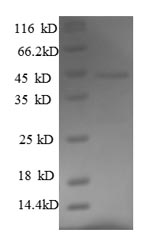Amino acids 18-262 constitute the expression domain of recombinant Mouse Faim3. The theoretical molecular weight of the Faim3 protein is 43.9 kDa. Expression of this Faim3 protein is conducted in e.coli. The Faim3 gene fragment has been modified by fusing the N-terminal 6xHis-SUMO tag, providing convenience in detecting and purifying the recombinant Faim3 protein during the following stages.
Mouse Fas apoptotic inhibitory molecule 3 (Faim3), also known as Fcmr, plays a crucial role in regulating apoptosis, particularly in immune cells. Fcmr functions as a cell surface receptor that modulates Fas-mediated apoptosis, impacting immune responses. Fcmr is implicated in both promoting and inhibiting apoptosis in lymphocytes, depending on the cellular context. Beyond apoptosis regulation, Fcmr is involved in modulating B cell activation and tolerance. Research on Fcmr spans various areas, including immune system regulation, autoimmune diseases, and cancer. Understanding its function provides insights into potential therapeutic strategies for immune-related disorders and cancer treatments.






